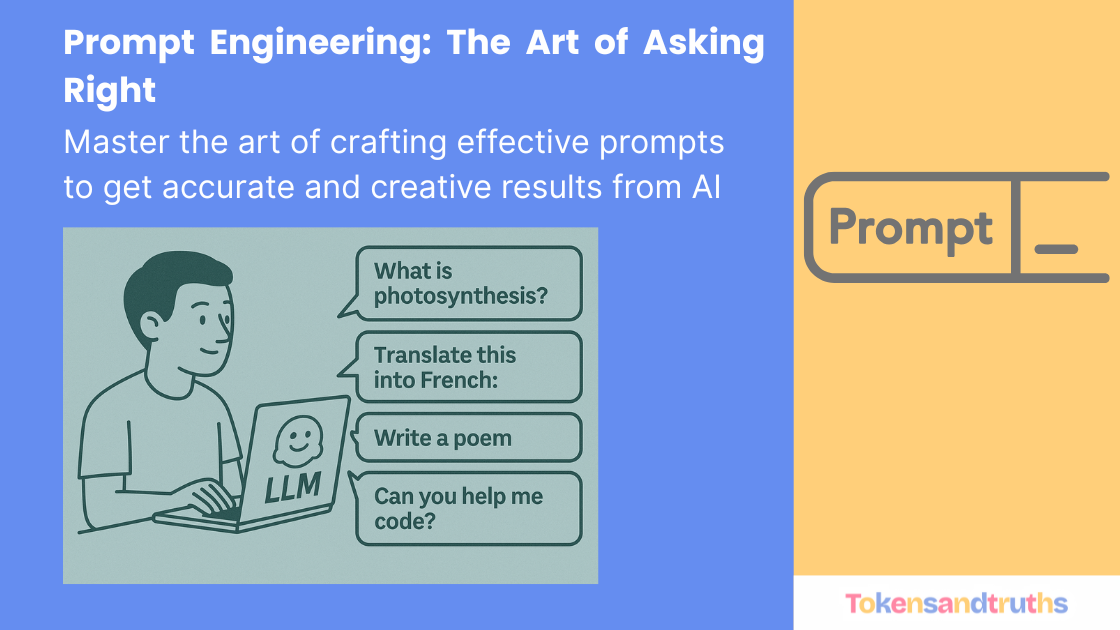Prompt Engineering: The Art of Asking the Right Questions

Prompt engineering is the art of asking the right questions to get the right answers.
A Quick History of Human–Computer Communication
In the early days of computing, humans interacted with machines through assembly language, a cryptic set of instructions understood only by computers and a handful of skilled engineers.
Then came modern programming languages like C, C++, Java, and Python, which made it possible to give structured, logical commands to computers and achieve desired results.
But after the invention of Generative AI, the way we communicate with computers changed forever.
A New Era: Everyone Can Be a Creator
You no longer need to be a software engineer to “program” a computer.
With Generative AI, everyone can be a:
- Programmer (by asking an AI to write or debug code)
- Teacher (by generating educational material)
- Artist (by describing an image or video you want to create)
- Writer or Lyricist (by crafting creative text prompts)
All you need is the ability to instruct the AI model effectively, and that instruction is called a prompt.
What Is a Prompt?
A prompt is the input you give to a generative model, usually written in natural language, to guide it in performing a task.
This is often called “Natural Language Programming.”
The better your prompt, the better your results.
Just like in traditional programming, garbage in, garbage out still applies.
What Can Generative AI Do?
Modern Large Language Models (LLMs) are trained on massive amounts of text, code, and multimedia data. They can perform a wide range of tasks, such as:
- Coding – Writing or explaining code (e.g., Codex, Claude, Qwen, Grok)
- Generating Images – Creating visuals from text (e.g., DALL·E 3, Gemini, Flux, MidJourney, Stable Diffusion)
- Generating Videos – Producing short clips from prompts (e.g., Sora, Veo 3)
- Generating Text – Writing essays, stories, or responses (e.g., GPT-5, Gemini, Llama, Phi, DeepSeek)
- Extracting Information – Parsing unstructured documents for facts
- Summarization – Condensing long text into key points
- Fact Checking – Verifying information accuracy
- Mathematics – Solving equations and reasoning through logic
And that’s only the beginning.
Why a Prompt Matters
Your prompt determines how well the model performs.
Let’s break down why prompts are so important.
1. They Control the Output
A vague prompt gives you a vague answer.
A focused prompt gives you a precise result.
Example:
❌ “Write an ad for shoes.”
✅ “Write a 3-sentence persuasive ad for running shoes for teenagers.”
2. They Provide Context
Context shapes understanding.
The model performs best when it knows who it is, what it’s doing, and what the goal is.
Example:
You are a specialist support agent.
Reply politely to this complaint.3. They Enable Task Specialization
You can tell the AI what “role” to play, like a lawyer, teacher, marketer, or coder.
That framing improves the tone and quality of the output.
4. They Ensure Accuracy and Consistency
Structured prompts create predictable, repeatable results.
Example:
❌ Bad Prompt:
Rate this review✅ Good Prompt:
You are an expert in understanding user sentiment from app reviews.
Your task is to predict how satisfied the user is with the app on a scale of 1 to 5,
based on the tone, wording, and emotion expressed in their review.
Use the following rating guide:
1 → Very Negative (angry, frustrated)
2 → Negative (disappointed, not happy)
3 → Neutral (mixed feelings)
4 → Positive (satisfied, minor issues)
5 → Very Positive (happy, enthusiastic)
Review: <Review>
Answer format:
Rating: <number 1 to 5>This prompt gives the model clarity, structure, and a consistent evaluation method.
Different Types of Prompts
LLMs can learn from the examples you provide.
Based on how much context you include, prompts are categorized into three types.
1. Zero-Shot Prompt
You provide only instructions without examples.
You are an expert sentiment analyst.
Your task is to classify the sentiment expressed in a movie review.
Review:
Bale is excellent as Batman, and the sheer care put into this is amazing.
Christopher Nolan is a baller. 10/10
Expected Output:
Positive2. One-Shot Prompt
You give one example before asking for a new prediction.
You are an expert sentiment analyst.
Your task is to classify the sentiment expressed in a movie review.
Review:
Bale is excellent as Batman and the sheer care put into this is amazing.
Christopher Nolan is a baller. 10/10
Sentiment:
Positive
Review:
This is one of the only movies I can rewatch and never get sick of! Great superhero film!
Predict the sentiment.
Expected Output:
Positive3. Few-Shot Prompt
You provide multiple examples so the model learns from patterns.
You are an expert sentiment analyst.
Your task is to classify the sentiment expressed in a movie review.
Review:
Bale is excellent as Batman and the sheer care put into this is amazing.
Christopher Nolan is a baller. 10/10
Sentiment:
Positive
Review:
A great disappointment to me, doesn't mean you can't enjoy it...
Sentiment:
Negative
Review:
Why do we fall, Bruce? So we can learn to pick ourselves up again.
Lots of less-than-stellar Batman movies led to this masterpiece.
Predict the sentiment.
Expected Output:
PositiveConclusion
Prompt engineering is not just a technical skill, it’s a creative one.
The better you communicate with AI, the better it performs for you.
Think of it as teaching a super-intelligent assistant to think the way you do.
If programming was about telling a computer how to do something,
prompting is about telling it what you want and why.
